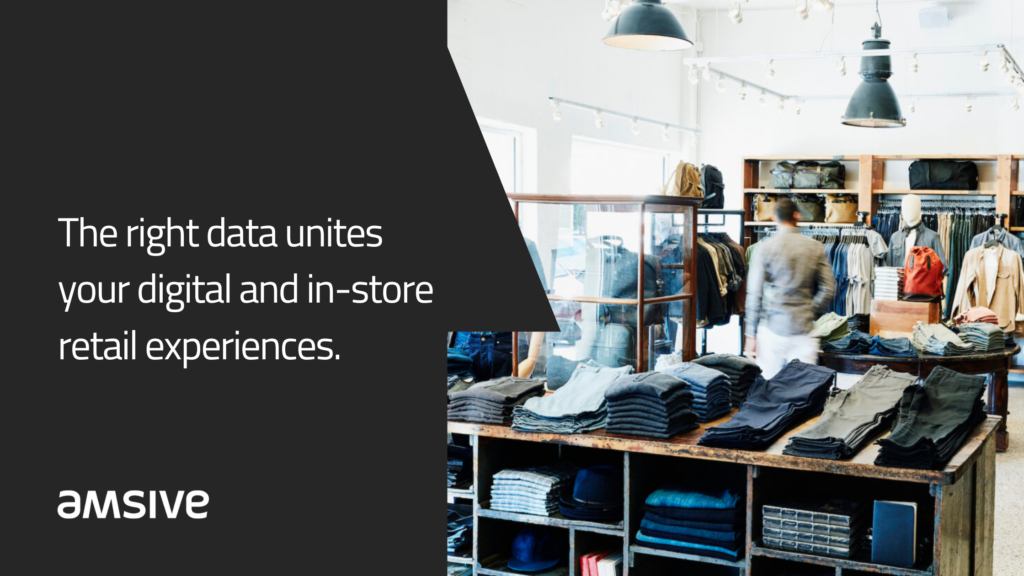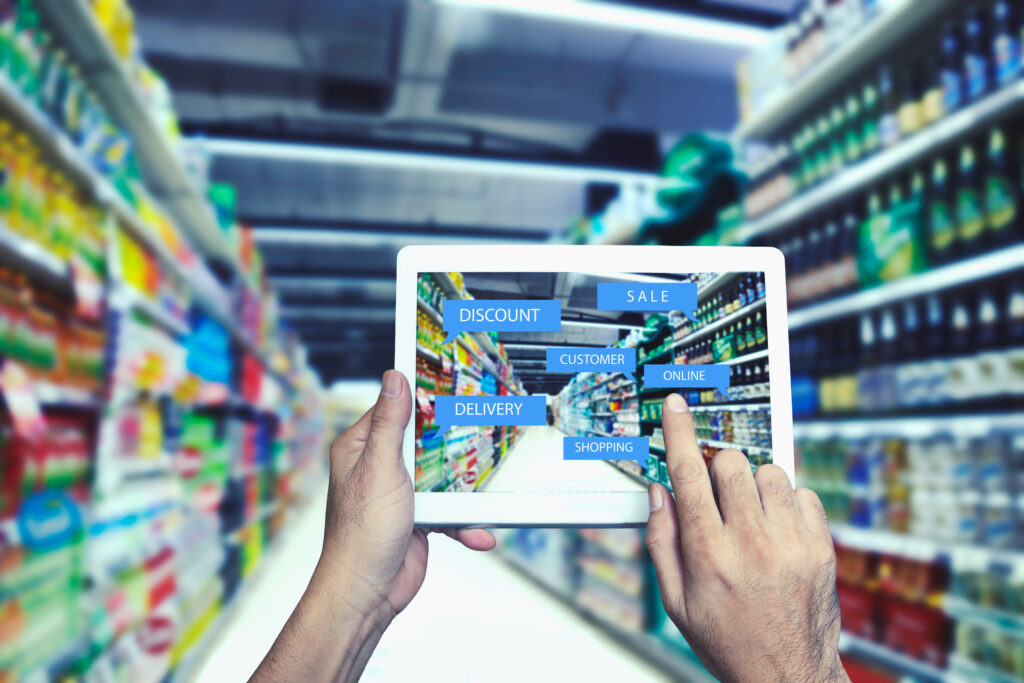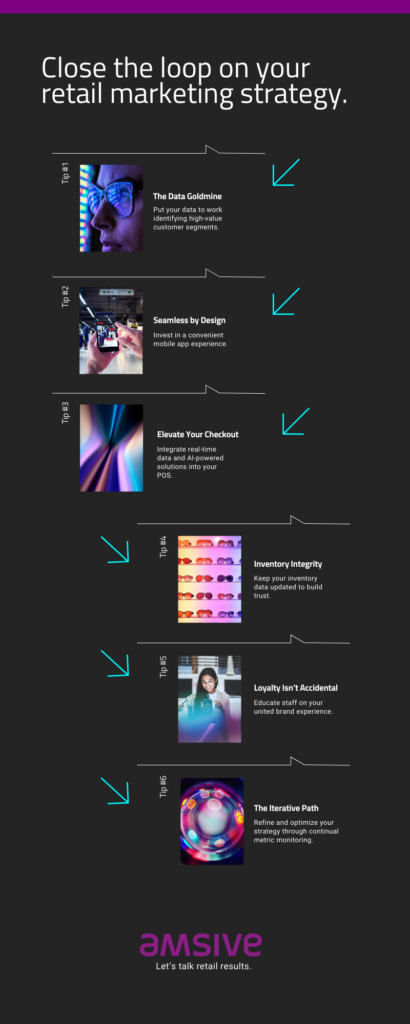Navigating the dynamic retail ecosystem? Pioneering retailers are harnessing the firepower of digital insights to supercharge their physical storefronts. The result? A transformative shopping experience that not only elevates customer engagement but also amps up in-store conversion rates.
You already know it’s not an either–or game between digital and physical retail spaces. We’re here to help you create a hyper-personalized journey that irresistibly draws customers from their screens right to your checkout counters.
Let’s dive deep into the game-changing advantages of this blended approach. Plus, we’ll show you why a seamless, tailored shopping experience isn’t just nice to have – it’s a non-negotiable for today’s discerning customer.
Jump To:
Unifying the Digital and In-Store Marketing Worlds
In the fiercely competitive world of retail, merely having an online or offline presence isn’t going to cut it anymore. Welcome to the era of unified retail, where effortless shopping journeys are the new normal. The rewards? Skyrocketing in-store conversions and customers who are so satisfied, they’ll think twice before shopping anywhere else.
The key to achieving this blend of digital and physical retail is mastering the data that tracks your shoppers’ movements and preferences. By collecting and analyzing customer data, whether it’s their click patterns online or in-store behaviors, you unlock the capacity for ultra-targeted marketing strategies.
For example, if analytics show that a group of your shoppers enjoys window shopping online but prefers to pull the trigger in-store, why not nudge them along? Serve up tailored promotions or in-store discounts that are too good to pass up – it’s smart retail.
The real genius comes when you integrate touchpoints across multiple channels, featuring services like buy-online-return-in-store or click-and-collect. Research shows these options don’t just add a layer of convenience for the customer, they also directly uplift the chances of converting those browsers into buyers.

Seamless Systems for Streamlined Experiences
Of course, to power this retail utopia, you need a robust infrastructure that fuses your online and offline realms. Think synchronized inventory management and cross-trained staff who are equally at home assisting online customers as they are in-store visitors.
You’re already aware that unified retail is a strategic imperative. Now, it’s time to focus on leveling up your game. By integrating digital insights and physical engagement, supported by data analytics and a multichannel strategy, you don’t just drive sales, you cultivate relationships. That’s how you ensure sustained loyalty and long-haul success.
Powering In-Store Experiences with Digital Optimization
The future of retail is about more than an in-store ambiance filled with decorations and sales tags. It’s also complete with layers of rich, actionable data. Let’s delve into the transformative power of user interface and data functionality, as well as how to integrate the use of mobile apps to create frictionless retail interactions.
Orchestrating Retail Excellence: Uniting UI with Data-Driven Functionality
Your user interface (UI) is the maestro that commands your customers’ retail symphony. A well-orchestrated, intuitive UI doesn’t just facilitate smooth navigation – it shapes the entire in-store experience. Now, couple that with data-driven functionality, where customer behaviors and preferences become real-time cues for optimizing your retail space.
To fully integrate these elements, you’ll want to:
- Turn every interaction into a personal touchpoint by harnessing customer data like browsing history.
- Optimize every square inch of your store by using data analytics for strategic product placement and inventory management.
- Equip your sales associates with data-powered tools to transform them from mere staff to customer success heroes.
The Power of Mobile Apps: Your Store’s Virtual Concierge
You already know that retail mobile apps are more than simple shopping aids. They’re the high-powered connectors that merge digital browsing with physical buying. In-app features such as real-time navigation and intuitive product search function as virtual concierges guide your customers effortlessly through your aisles.
To use your mobile app to maximize marketing performance and sales, consider:
- Embedding in-app navigation that serves as a GPS through your store’s products.
- Offering hyper-personalized product suggestions based on each user’s history and preferences.
- Integrating chatbots or direct messaging features, turning your app into a real-time customer service powerhouse.
By mastering these areas of UI and data-driven functionality, along with maximizing the capabilities of your mobile apps, you’re not just offering a shopping experience – you’re delivering a loyalty-inducing personalized shopping encounter. And remember, the tone you set can make the difference between a one-time purchase and a lifetime customer.
Next up, we’re shifting gears to a topic that’s the secret sauce of any successful retail strategy. Read on to learn some top strategies to boost in-store conversions.

Elevating In-Store Conversions with a Data-Driven Blueprint
Unlocking the intricacies of consumer behavior can be difficult to navigate. In this section, we’re diving into advanced strategies, including turning casual browsers into loyal customers, all through the alchemy of smart marketing and tech-driven innovation.
The Symphony of Hyper-Personalized Campaigns
You already know that a one-size-fits-all approach won’t cut it in today’s competitive landscape. The real game-changer? Utilizing behavioral analytics, past purchase data, and predictive algorithms to craft personalized experiences that feel like they’re tailor-made for each customer.
Sure, promotions can drive foot traffic. But a hyper-personalized campaign that nails a customer’s unspoken desires? That transforms foot traffic into revenue engines. Maintain a consistent narrative across all channels, online or offline, to create a harmonious brand image that customers find irresistibly reassuring.
Activating the Power of Social Proof
Trust is more than a five-letter word – it’s the linchpin of conversion. Integrate user-generated content like Instagram posts of customers rocking your product, or Twitter shoutouts that border on brand love letters.
Layer in testimonials and reviews that address pain points directly, essentially letting your satisfied customers disarm any reservations your potential buyers may have. You’re not just selling products. You’re orchestrating a chorus of advocates that amplify your brand’s credibility.
Urgency and Sustainability: Balancing Flash Sales with Long-Term Loyalty
Nothing spikes dopamine like the ticking countdown of a limited offer. That tick-tock isn’t just sound, but the rhythm of urgency that turns window shoppers into buyers.
But you’re savvy enough to know that today’s consumers can easily discern a disingenuous “limited-time” offer. So, let’s get into the nuts and bolts of striking the right balance between high-adrenaline tactics and evergreen marketing campaigns.
High-Adrenaline Tactics: Start with A/B testing different versions of limited-time offers to see what truly resonates. Leverage real-time analytics to make quick adjustments. Consider using geo-targeting for flash sales or implementing countdown timers to ramp up the urgency. These are your tools for those flash-fire sales.
Evergreen Marketing: On the flip side, use content marketing, SEO, and loyalty programs to build slow-burn loyalty. Consistent email marketing campaigns, how-to guides, and value-driven social media posts are all long-term plays. They help establish your brand as a go-to resource and keep customers coming back long after the sale ends.
Data Integration: Integrate data insights from both strategies into a centralized dashboard. This allows you to see what elements from each are driving conversions and customer loyalty. Then, fine-tune your strategies accordingly.
By balancing these approaches, you’ll create a robust retail strategy that captures the best of both worlds: the immediate impact of high-adrenaline tactics and the lasting relationships built through sustainable marketing.
Tech-Enabled Retail Ecosystems: The Invisible Force Guiding Conversions
Your POS is no longer a glorified calculator – it’s the nerve center of your retail operation. AI-powered, data-backed, and insight-rich, imagine a system that understands your customer’s purchase history, anticipates needs, suggests add-ons, and even predicts stock requirements.
Key components of data-driven POS systems include:
- Predictive personalization that adjusts recommendations in real-time.
- Dynamic offer curation that taps into micro-moments of purchase intent.
- Inventory management that’s more Wall Street than warehouse, optimizing stock levels in real-time.

Sculpting the Ideal eCommerce Experience
Your eCommerce platform shouldn’t be an isolated island. It’s the digital avatar of your physical space. Focus on UX design that complements the in-store journey – easy, intuitive, and engaging. And create a mobile-responsive experience that tracks seamlessly with in-store offerings, all unified by a centralized POS system.
Elevate the digital shopping adventure by:
- Designing for thumb-friendly navigation because the future of eCommerce is one-handed.
- Crafting a mobile-to-store journey by incorporating features like “Reserve in Store” or “Same-Day Pickup.”
- Streamlining payments and checkout with a unified payment gateway that syncs with in-store systems.
Knowing these strategies is fantastic, but measuring their efficacy? That’s where the real payoff lies. Up next, we’re looking at how to leverage analytics to measure in-store conversions.
Cracking the Analytics Code: Mastering In-Store Conversions Through Data Intelligence
To supercharge your in-store conversions via online activities, you’ve got to be relentless in measuring your marketing impact. Take a tool like Google Analytics – it’s not just another dashboard, it’s your command center for decoding consumer behavior in real-time.
Closely watching key metrics, like online-to-offline interactions, elevates your marketing game. For example, tracking the instances where an online engagement translates into a store visit or purchase gives you a laser-focused view of how your digital tactics are catalyzing real-world returns.
Don’t stop at transactional data. The essence of your brand’s pull lies in cultivating enduring customer relationships. Metrics such as repeat visits, satisfaction scores, and how customers engage with personalized messaging provide a 360-degree perspective on your multichannel marketing effectiveness.
Mastering the Conversion Algorithm
Capturing conversion rate data is your go-to strategy for revealing the power of your online initiatives on in-store conversion. Think of it as decoding the DNA of your customer journey, uncovering which online activities actually drive foot traffic to your brick-and-mortar stores.
Keeping tabs on conversion rates from every angle, be it your website, social platforms, or even in-store interactions, serves as your panoramic lens into your marketing health. This holistic view allows you to decode intricate customer behaviors, guiding them through the sales funnel with unmatched precision.
Remember that conversion rates aren’t static – they’re your dynamic performance indicators. Periodically revisiting these metrics uncovers evolving trends in consumer preferences, positioning you to agilely pivot your strategies and maintain your competitive edge.
As we pivot from short-term conversions to long-term customer relationships, let’s dive into our next essential element – how to craft customer satisfaction that wins hearts and brand loyalty.
Crafting Customer Satisfaction for Enduring Business
Expertise and incentives are more than buzzwords – they’re the dual engines that power repeat business. Expertise is your brand’s foundation, making you the go-to source in your field. Incentives, like exclusive offers or loyalty programs, are the catalysts that spark immediate customer action.
When these two elements synergize, they transform occasional visitors into brand ambassadors. You’re not just closing a one-time sale. You’re launching a lasting relationship. Customers not only come back, but they also amplify your brand’s reach by sharing their positive experiences. Next, let’s dive into actionable strategies for boosting customer loyalty.
Empowerment Through Staff Excellence in a Unified Retail World
Training your staff to excel in both digital and physical spaces is a game-changing move for any retail business. By being experts in not only the products but also the intricacies of your ecommerce site and mobile app, employees become multi-faceted assets.
Take for instance a customer browsing in-store. With a well-informed staff, that customer can get immediate access to online reviews, related product suggestions, and even inventory information for online-exclusive items. This fusion of in-store and online knowledge elevates the shopping experience, making it not just seamless but truly memorable.
When your staff can comfortably navigate and link the digital and in-store worlds, it adds a layer of personalized service that customers will come back for. This well-rounded approach to staff training not only satisfies but goes beyond customer expectations, setting the foundation for long-term loyalty and brand advocacy.
Incentives That Speak Volumes
People love to feel special, which is why loyalty programs and exclusive discounts can be game-changers. Earn-and-redeem point systems do more than prompt a second purchase – they’re data mines that reveal invaluable insights into customer behaviors.
Returning customer discounts add that extra layer of “exclusivity,” cultivating a community around your brand. And let’s not ignore the golden opportunities presented by seasonal promotions. These time-sensitive offers inject a sense of urgency, pulling in customers who might otherwise bypass your store.
Proof in the Pudding: Brands Getting It Right
Take Nike, for instance. They’ve blurred the lines between online and in-store shopping. With their app, you can not only customize your footwear but also book fitting rooms, providing a retail experience dressed in convenience and personalization.
Or consider Sephora’s multichannel mastery. Their Virtual Artist feature brings augmented reality into online cosmetics shopping, bridging the confidence gap and often translating into in-store sales. And let’s not forget Amazon Go, a disruptive force merging online tech with the physical retail space, offering a frictionless, queue-free shopping experience.
Whether it’s your staff’s expertise or targeted incentives, whether you’re following in the footsteps of giants like Nike, Sephora, or Amazon – the ultimate goal is to exceed customer expectations every single time.
You’ve got online-to-offline conversions down, and you know what makes your customers happy. Keep reading to learn how to tie it all together with a unified retail strategy.

Closing the Loop on Your Unified Retail Strategy
Digital marketplaces aren’t just an alternative to in-store shopping anymore. They’re an intrinsic part of the retail mosaic. Here’s how to bring that holistic strategy to life:
The Data Goldmine: Don’t just collect data – put it to work. Use your analytics to identify high-value customer segments and craft tailor-made promotions. Make data your chief strategist for campaigns that resonate.
Seamlessness by Design: Features like buy-online-pickup-in-store aren’t only conveniences – they’re necessities. Invest in a mobile app that acts as a conduit between the digital and physical worlds, enhancing the customer experience at every touchpoint.
Elevate the Checkout: Your POS system can be smarter. Integrate AI and real-time data to not only manage inventory effectively but also to offer highly personalized promotions right at the point of purchase.
Inventory Integrity: Keep your stock-level data as live as your customer’s online feed. Real-time, cross-channel inventory info isn’t just good practice – it’s the foundation of trust between you and your consumer.
Loyalty Isn’t Accidental: Incentive programs and staff expertise are not standalone entities – they’re vital elements of a curated in-store experience that hooks customers for the long run.
The Iterative Path: Retail isn’t static, and neither should your strategies be. Constantly monitor your metrics to adapt and refine your campaigns, aiming for a customer journey so seamless it feels intuitive.
Industry giants like Nike, Sephora, and Amazon have already laid the blueprint for an integrated retail experience. Now’s your chance to evolve, not just keep pace. Our retail experts are here to help craft a unified commerce strategy aligned with your brand’s unique objectives.
A comprehensive audience strategy means amplified performance and also means marketers must be conscientious stewards of customer data.
Dig deeper into how to create high-performing video for your retail business, or let’s talk about how to achieve more for your marketing — and your business.






